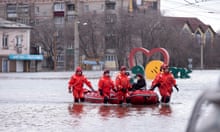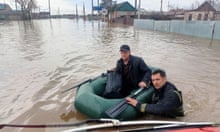At least seven people have been killed and dozens injured as Storm Ciarán battered north-west Europe with torrential rain and winds of up to 200km/h (124mph), damaging homes and forcing schools to close and airlines and train companies to halt services.
A truck driver was killed by a falling tree in the Aisne département of northern France, authorities said on Thursday, while more than 1.2 million people lost their electricity supply, including about half the population of Brittany.
A 70-year-old man died in Le Havre after falling off his balcony in an accident police described as linked to Storm Ciarán’s record-breaking winds, while in Spain a woman was killed when a tree fell on her in central Madrid and three people were injured.
Two people died in central Ghent, Belgium, after being hit by falling branches from trees. One of the victims was five years old, while the other one was a 64-year-old German woman visiting Belgium. A third was seriously injured in the port city of Antwerp when a high wall gave way in record winds, authorities said.
In the Netherlands a person was crushed to death by a tree in Venray in the southern province of Limburg, local media said. At least 10 other people were injured by flying debris around the country, at least three seriously.
The German fire service also said on Thursday that a 46-year-old woman from Bavaria who was on a family holiday with her husband and two children had been killed by a falling tree while out hiking near Rammelsberg in the Harz mountains.
As huge waves slammed into French ports and shorelines, 15 people, including seven firefighters, were injured by falling trees, mainly in Brittany, where authorities in Finistère urged people to stay at home to avoid winds of 207 km/h (129 mph).
Local authorities closed parks, forests and seafronts, local trains were cancelled and all roads in Finistère were shut. More than 1,300 people were relocated, mainly from camp sites, and several houses evacuated in Brest after a crane toppled over.
Nearly all mainland France’s coastline was under a severe weather warning on Thursday morning. In the northern Pas-de-Calais region, authorities opened gyms and shelters for migrants hoping to make it to Britain by small boat.
The French transport minister, Clément Beaune, urged people to avoid driving and exercise caution when travelling across areas with weather warnings. “We see how roads can be fatal in these circumstances,” Beaune said told France-Info radio.
Storm Ciarán, which follows Storm Babet two weeks ago, was driven by a powerful jet stream that swept in from the Atlantic, unleashing heavy rain and record winds that have already caused heavy flooding in Northern Ireland and parts of the UK.
after newsletter promotion
Rail and ferry services, including the Eurostar that links the Netherlands, Belgium, France, Germany and the UK, experienced cancellations and delays and the Dutch national airline, KLM, cancelled all flights leaving and arriving in the Netherlands.
The eighth edition of the Dutch national headwind cycling championships, held on the 8.5km (5.3-mile) Oosterscheldekering storm surge barrier when south-westerly gales exceed force seven, was hastily organised, but then called off because the wind was too strong.
Dutch weather forecaster Roosmarijn Knol said the timing of the storm had a major impact particularly on the number of trees that fell. “Due to a warm autumn with a lot of rain, trees still have their leaves, and the ground is as wet as a sponge,” she said.
“That means especially that weak trees have a good chance of falling over. That is a big difference from an autumn storm at, say, the end of November, when all the leaves have already fallen,” Knol said.
The effects of the storm were felt as far south as southern Spain and Portugal, where several regions were on red alert, fallen trees caused power cuts and train services were disrupted. Spanish authorities warned of waves as high as nine metres along the northern Atlantic coast and the Spanish airport operator said 42 flights were cancelled.










